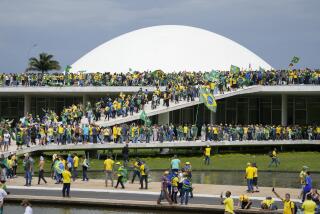18 Justices Freed; Kidnapers Seized : Costa Rica: Gunmen are duped with promises they could leave, then are captured at the airport.
SAN JOSE, Costa Rica — Ending a tense 74-hour standoff, gunmen Thursday freed 18 Supreme Court justices and five court employees after having received a ransom payment and promises that they could leave the country. Minutes later, the kidnapers were captured by police sharpshooters after shots were fired at San Jose International Airport.
Government and Red Cross officials said none of the kidnapers were wounded. The liberated justices and other hostages were in generally good condition.
“Finally!” said Supreme Court President Edgar Cervantes, looking tired and unshaven as he emerged from a vehicle that carried him to freedom from the Supreme Court building.
One of the leaders of the kidnaping gang, in a letter written to a local television station, said he staged the attack on the court to raise money to cure a liver ailment after government health plans refused him care.
Five gunmen, calling themselves the “Commando of Death,” stormed the Supreme Court in San Jose on Monday as the magistrates gathered for a weekly meeting. The kidnapers seized 19 justices and five administrative employees, later freeing one of the justices for health reasons. The gunmen demanded a ransom of $20 million--which they soon lowered to $8 million--and safe passage to a South American country.
Public Security Minister Luis Fishman said the kidnapers ultimately settled for a ransom equivalent to $150,000 paid by families of the hostages. Fishman told reporters the gunmen had been promised they would be flown to Guatemala.
Court President Cervantes spoke briefly with reporters, saying he feared for his life “a bunch of times.”
“At first, they were very violent,” said the magistrate, wearing a rumpled brown shirt and three days’ growth of gray whiskers.
Felix Soto, a court messenger, said: “I would like the people who did this to have to live like that, in captivity. I feared for the lives of everyone.”
The climax to the siege that shocked and riveted this traditionally peaceful country began under a slow April drizzle as a caravan of vehicles with tinted windows entered the Supreme Court complex.
As government helicopters circled overhead, the judges were ushered into the cars and swiftly escorted away by motorcycle police and patrol cars.
The magistrates, many carrying plastic bags of what looked like clothes, were delivered to the Public Security Ministry. In a separate caravan, the kidnapers were taken to a restricted area of San Jose International Airport, where Public Security Ministry officials said a small airplane awaited them.
Also awaiting were police sharpshooters. Reporters, who were denied access to the area, heard several shots fired. Authorities quickly announced that the kidnapers had been detained.
“We are extremely satisfied (with the way the siege ended) and thank God,” President Rafael Angel Calderon said.
The two ringleaders of the Commando of Death were identified by authorities as brothers Guillermo and Gilberto Fallas Elizondo, former police agents who had worked for the court system and had received extensive military training here and in the United States.
Guillermo Fallas, before the hostages were freed, wrote a two-page letter to an anchorwoman at Costa Rica’s Teletica television station.
In the letter, Fallas apologized profusely for the “treason” he committed, saying he was forced to act because the state social security system and the courts had refused to help him obtain treatment for chronic cirrhosis of the liver.
“I am from a very honorable family, who with extreme pain (was forced) to betray my beloved Costa Rica,” Fallas wrote. “Pardon me, pardon me, pardon me, Costa Rica.”
He denied his gang would have killed the hostages, saying threats to do so by blowing up the entire Supreme Court were made by the kidnapers to exert pressure on authorities. But Fishman said the Fallas gang specifically threatened to kill two magistrates if certain demands weren’t met.
The Supreme Court standoff was the third hostage crisis here in seven months. Fishman conceded that the government’s earlier, controversial approaches in which the kidnapers were given money and allowed to leave the country “maybe were somewhat mistaken.”
More to Read
Sign up for Essential California
The most important California stories and recommendations in your inbox every morning.
You may occasionally receive promotional content from the Los Angeles Times.











